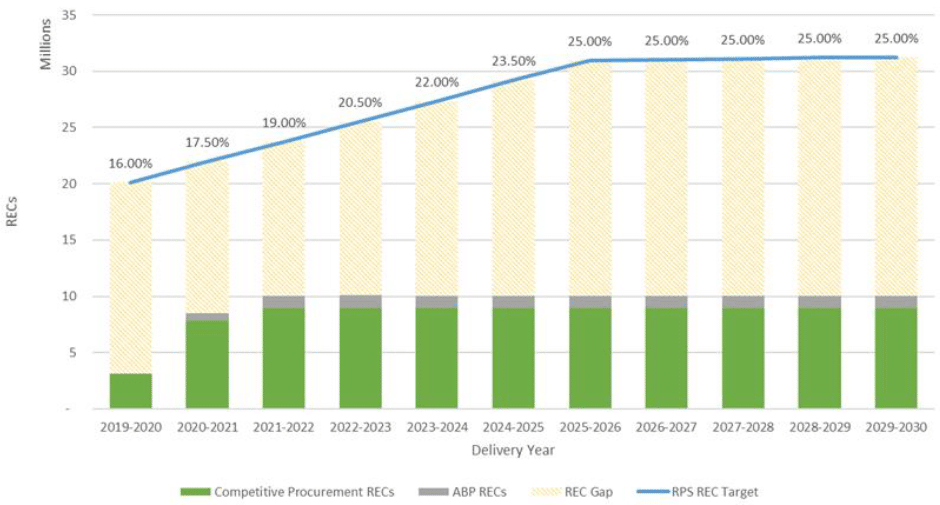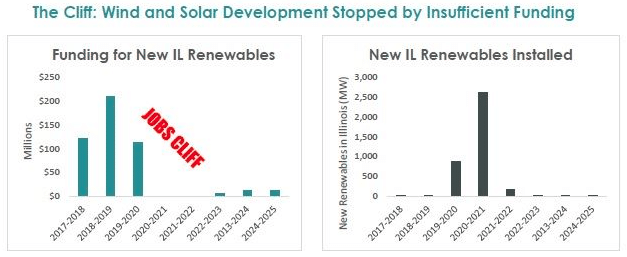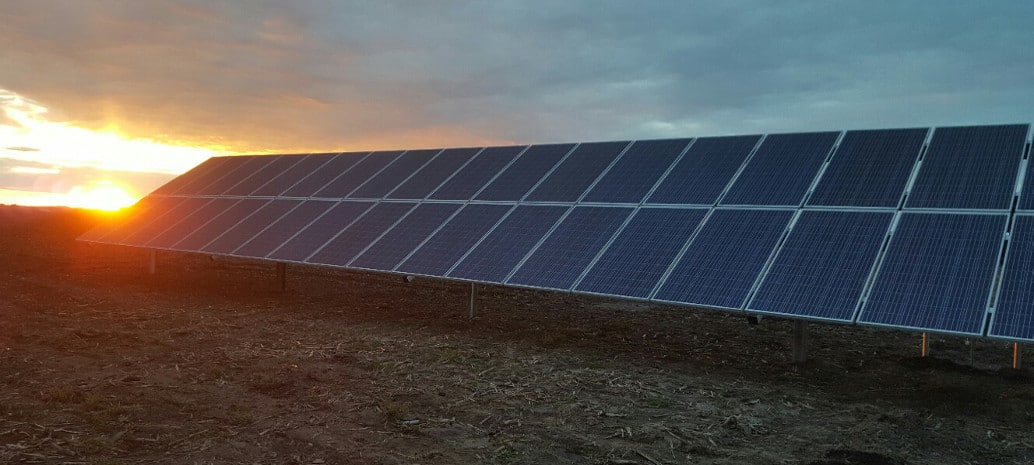Renewable energy mandates have a generally strong track record. When states pass policies that require utilities to source a certain portion of their generation from renewable energy, these are usually met on time, and in some cases, like in California, deployment of solar has blown through the annual targets.
The exception is Illinois. Despite passing a renewable portfolio standard (RPS) in 2008 that required that utilities source 25% of their electricity from renewables in 2025, what has been described as broken program design meant that deployment came nowhere near the targets set in law.
The passage of the Future Energy Jobs Act (FEJA) at the end of 2016 was supposed to fix these issues and allow for the state to meet its targets; however it appears that this effort will also not, on its own, accomplish the level of renewable energy deployment needed to meet the state’s mandate.
As revealed in a series of slides published by the Illinois Power Agency (IPA), not only is the number of renewable energy credits currently in circulation wildly inadequate to meet state targets, but funding for such RECs will run out some time in the next two years.
Illinois would need to issue 20 million RECs to meet the 2019-2020 RPS target, and more than 30 million to reach the 2025-2026 target, but the program will run out of money in 2021-2022, well before these targets are met.

This appears to be a result of the program design, with the funding for community solar and distributed generation under the Adjustable Block Program eating into the overall funding for RECs, which is alluded to by IPA statements.
“Community solar adders created budgeting unknowns,” observes IPA.
Progress to date
Analysis of U.S. Department of Energy data by pv magazine has confirmed that Illinois is nowhere near reaching its targets. In-state renewables (almost exclusively wind) met only 8.6% of Illinois’ power demand last year, much less than the 13% mandated by law. For solar, it was even further behind, with solar supplying around 0.1% of the state’s power, only 1/8th of the requirement in the RPS carve-out.
However, FEJA has still enabled the state to deploy larger volumes of solar than ever before. IPA has already held two large-scale procurements for solar in 2018 and early 2019, and according to the Midcontinent Independent System Operator (MISO) there is currently a 110 MWac and a 140 MWac solar project under construction in the state. Together these will increase Illinois’ installed solar capacity by roughly 4x.
Additionally, at last count the state had awarded 215 MWac of community solar and 124 MWac of large distributed generation projects through the Adjustable Block program.
The net result of these will be a tremendous increase in Illinois’ installed capacity over the next few years. But it will also exhaust available funding.
The path forward
Much of Illinois’ solar community is rallying behind the Path to 100 bill (HB 2966/SB 1781), which advocates say provides enough funding to meet the current targets, and will avoid a boom-bust cycle in employment in the industry.

Graphic: ISEA
A separate bill, the Clean Energy Jobs Act, is currently pending in the legislature as well, and has the support of much of the state’s environmental community. With these two competing pieces of legislation, the path forward is not clear at this time. But either one would represent progress.
“Under any circumstance it is going to be extremely difficult make our 25% goal by the year 2025-2026,” notes Mark Burger, a community solar consultant and former president of the Illinois Solar Energy Association. “What enabling legislation will do is to put us on a trajectory to get to a higher percentage by 2030 and 2050.”
This content is protected by copyright and may not be reused. If you want to cooperate with us and would like to reuse some of our content, please contact: editors@pv-magazine.com.









By submitting this form you agree to pv magazine using your data for the purposes of publishing your comment.
Your personal data will only be disclosed or otherwise transmitted to third parties for the purposes of spam filtering or if this is necessary for technical maintenance of the website. Any other transfer to third parties will not take place unless this is justified on the basis of applicable data protection regulations or if pv magazine is legally obliged to do so.
You may revoke this consent at any time with effect for the future, in which case your personal data will be deleted immediately. Otherwise, your data will be deleted if pv magazine has processed your request or the purpose of data storage is fulfilled.
Further information on data privacy can be found in our Data Protection Policy.